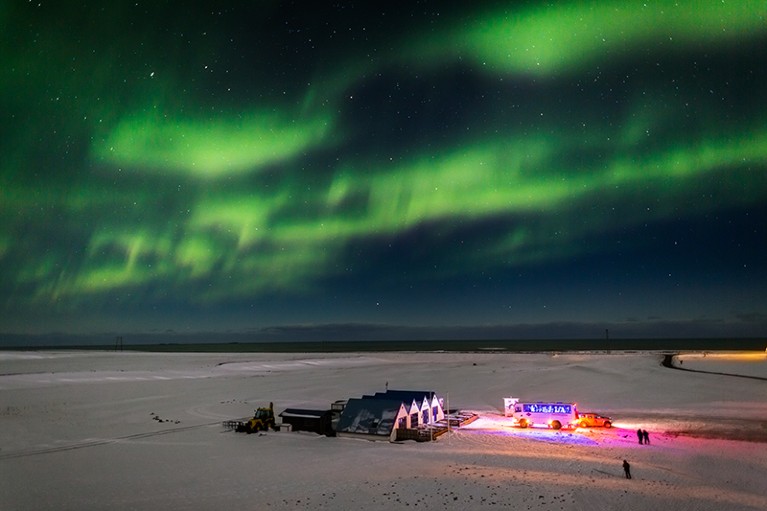
The Northern Lights — seen over Iceland — are caused by charged particles in the solar wind hitting Earth’s magnetosphere.Credit: Arctic-Images/Getty
The Spinning Magnet: The Electromagnetic Force That Created the Modern World — and Could Destroy It Alanna Mitchell Dutton: 2018.
The year 1906 was a momentous one for physics and Earth science. Physicist J. J. Thompson was awarded a Nobel prize for his discovery of the electron; Albert Einstein’s two papers on special relativity were being read across the globe; the geologist Richard Oldham discovered Earth’s metallic core using seismic waves. And, in a remote location in central France, an obscure physicist called Bernard Brunhes discovered that about 780,000 years ago, Earth’s magnetic field had flipped its polarity. The north magnetic pole replaced the south, and vice versa, an event recorded in volcanic rocks across the globe.
In The Spinning Magnet, science journalist Alanna Mitchell weaves together the story of Earth’s magnetism. She covers its intellectual roots in ancient Greek natural philosophy: Thales of Miletus and Aristotle both speculated on the origins of magnetism. She then follows the hints of it that emerged through the era of classical physics in the nineteenth and early twentieth centuries, and into the present day, using Brunhes’s startling discovery as the subplot. Mitchell adds a generous helping of tension to the mix, thanks to the social implications of that discovery: the potential loss of Earth’s dipole, the ‘magnetic shield’ that deflects harmful particles from the solar wind.
Throughout The Spinning Magnet, Mitchell constantly reminds us that polarity reversals of the geomagnetic field have happened thousands of times in the geological past. We are overdue another. Indeed, Earth’s dipole has decreased in strength by nearly 10% since it was first measured by Carl Friedrich Gauss in 1840. That continues: we are on course to lose our magnetic shield within a couple of millennia. Mitchell even pinpoints where this might already be happening, notably beneath the South Atlantic Ocean. There, on the surface of Earth’s liquid outer core, geoscientists are finding evidence that the magnetic field is reversing its direction over several million square kilometres, an area that grows with each passing decade.
So, will the north magnetic pole soon become the south, or is this just a transient episode to be followed by a rebound in magnetic-field strength? Meanwhile, what about our vulnerable infrastructure? How, for instance, will the patchwork US electrical grid respond to extreme solar storms when the magnetic shield goes down? To address these questions, Mitchell has interviewed dozens of geoscientists, space scientists and biologists, offering a readable account of what is probably in store for us, magnetically speaking, and how we got to this point.
More intriguing, however, are the historical players Mitchell describes in this scientific saga. The earliest to get prime billing is Petrus Peregrinus de Maricourt, a medieval French scholar and crusader whose 1269 Epistle on the Magnet launched the inquiry into Earth’s magnetism in the West. (The subject was already known in the East, especially China, from around 200 bc onwards.) Then comes a trio of Englishmen, from the sixteenth to the eighteenth centuries. These were William Gilbert, astronomer, physician to Elizabeth I and author of the 1600 treatise De Magnete; Henry Gellibrand, who showed that Earth’s magnetic field varies with time; and Edmond Halley of comet fame, whose representation of the geomagnetic variation became the familiar contour map.
Next are the pioneers of electromagnetism from the eighteenth to the nineteenth centuries: Benjamin Franklin, André-Marie Ampère, Hans Christian Ørsted, Michael Faraday and James Clerk Maxwell. The most prominent woman on the marquee is geophysicist Inge Lehmann, who in 1936 discovered Earth’s solid inner core. Finally, there is the large group of other twentieth-century geoscientists who quantified the theory of plate tectonics by using magnetic reversals recorded in igneous and sedimentary rocks. Through this, they demonstrated that the age of the ocean crust increases systematically with distance from the mid-ocean ridges.
Mitchell’s portrait gallery is researched with a depth and breadth that make its protagonists’ triumphs and failures compelling. She also gives entertaining accounts of today’s working geoscientists. They include geologist Jacques Kornprobst, custodian of Bruhnes’s legacy, and Daniel Baker, an authority on extreme space-weather events. Her interviews provide insights into their thoughts and actions that transcend the stereotypes of inscrutable nerd or heroic explorer.
The perceptive reader will notice a few disconnects. For one, Mitchell gives short shrift to the explanation of just how Earth generates and maintains its magnetic shield in the metallic core. The human drama behind recent developments, which featured innovative numerical experiments using massive computers, is also curiously omitted. And lastly, the subtitle’s dire warnings of impending doom (The Electromagnetic Force that Created the Modern World — and Could Destroy It) is an unnecessary distraction, being no match for the real-life stories inside.

 Quake news from America
Quake news from America
 Radiant realms
Radiant realms





